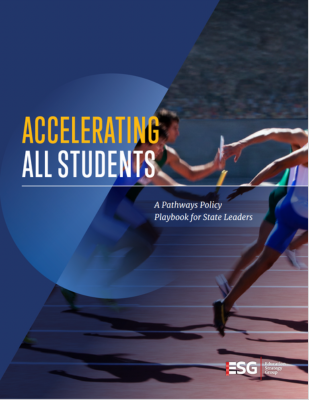Resource: Accelerating All Students
A Pathways Policy Playbook for State Leaders
When implemented effectively, accelerated pathway programs enable students to identify career opportunities, develop essential workforce skills, ease their path to college, save money, and reduce the time it takes to achieve their educational goals.
 Unfortunately, these programs are not always accessible to all students. Accelerated pathways should not be limited to students who are already advanced or pre-disposed to attend college. All students should have access to educational experiences that provide them with opportunities to gain knowledge, explore their interests, build skills, and gain on-the-job experience. These opportunities help students build networks and result in a quicker path to achieving their ultimate goal of landing a career that will enable them to live prosperous and fulfilling lives. High-quality accelerated pathway models integrate:
Unfortunately, these programs are not always accessible to all students. Accelerated pathways should not be limited to students who are already advanced or pre-disposed to attend college. All students should have access to educational experiences that provide them with opportunities to gain knowledge, explore their interests, build skills, and gain on-the-job experience. These opportunities help students build networks and result in a quicker path to achieving their ultimate goal of landing a career that will enable them to live prosperous and fulfilling lives. High-quality accelerated pathway models integrate:
- Dual enrollment sequences in programs of study that enable students to earn 12 or more college credits by high school graduation toward a degree in a high-wage, high-demand field, at no cost to students
- Career-connected learning opportunities aligned to course curriculum to provide career awareness, exploration, preparation, and training
- Simplified student transitions between levels/institutions, supported by strong advising and navigation support that helps students understand college and career options and make better informed choices
State leaders play a crucial role in defining and scaling accelerated pathways, and they have a wide range of policy levers at their disposal. Depending on their state context, this could include legislation, state budget processes, executive orders, agency rules and guidance, as well as direct technical assistance and support. This policy playbook outlines a set of policy actions that state leaders can implement to prioritize and scale accelerated pathways, focusing on policies that support all students, regardless of their demographic characteristics, family income, or geographic location. The policy actions focus on setting a vision, building the system, and expanding student support.



